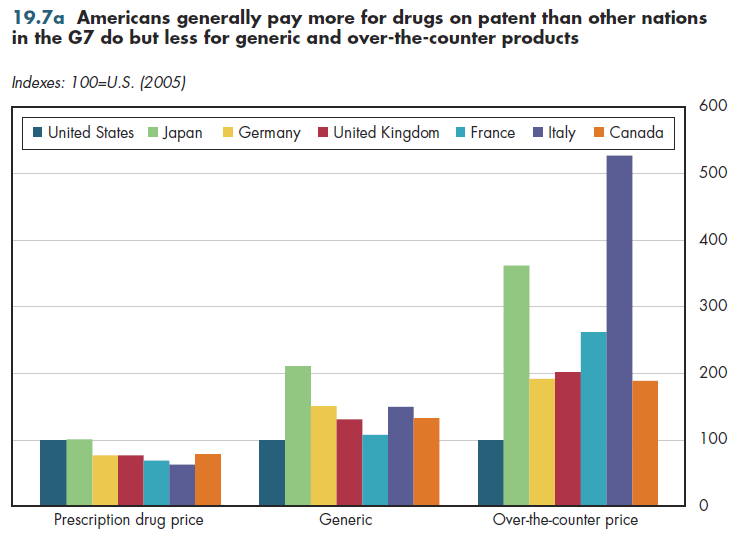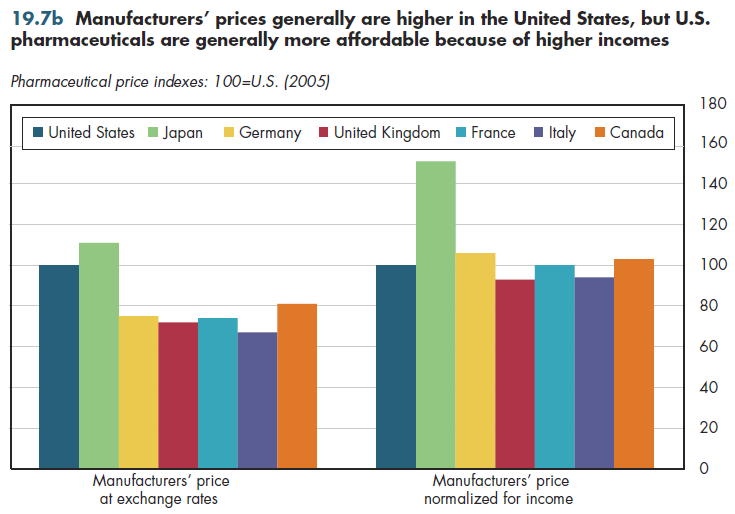Download PowerPoint versions of both figures.
Inside Collection (Book): American Health Economy Illustrated
19.7 Americans Pay Higher Prices for Brand-Name Drugs among Major Industrialized Countries
Summary: Americans pay higher prices for brand-name pharmaceuticals but lower prices for generic and over-the-counter drugs than do residents in other major industrialized countries.
U.S. pharmaceutical spending per capita is higher than in the rest of the G7. This is true whether spending is measured in terms of manufacturer prices or in terms of public prices that include wholesaler and retailer distribution margins and value-added taxes. Americans tend to use stronger drug formulations. Thus, even though U.S. prescription drug use is second lowest within the G7 based on doses per capita, the United States is exceeded only by Canada and France in terms of number of grams per capita.
Americans pay higher prices for drugs on patent, but much lower prices for generic medications and over-the-counter medications not requiring a prescription (figure 19.7a). Generic medications account for 70 percent of U.S. pharmaceuticals by volume but less than 20 percent by sales. Prices for brand-name drugs still enjoying patent protection can be set much higher. This allows the manufacturers to recoup the hundreds of millions of dollars in R&D costs that it takes on average to bring one new drug to market. Generics are less expensive in the United States because many factors in the pharmaceutical market contribute to making the generic sector extremely price competitive. Greater regulation, among other factors, contributes to higher generic prices elsewhere in the G7.

The prescription drug price index shown in figure 19.7a is a weighted average of brand name and generic prescription medications. This index illustrates that, except in Japan, the lower prices Americans pay for generics do not offset the higher prices they pay for patented pharmaceuticals. However, drugs, like most market commodities, are priced based on willingness to pay, which in turn reflects ability to pay.
Using manufacturers' prices converted to U.S. dollars at the prevailing exchange rate, the United States has higher pharmaceutical prices than any other G7 competitor except Japan. However, when this same price index is normalized to eliminate differences in GDP per capita (an approximate measure of average income), U.S. drugs are more affordable than in Japan, Germany, and Canada (figure 19.7b). Among the G7, only Italy and the UK have more affordable drugs than in the United States.

Downloads
References
- Danzon PM and MF Furukawa. International Prices and Availability of Pharmaceuticals in 2005. Health Affairs 2008; 27(1):221-33.
Collection Navigation
- « Previous module in collection 19.6 US Relies Heavily on Specialists in Contrast to Primary Care Doctors
- Collection home: American Health Economy Illustrated
- Next module in collection » 19.8 Medical Malpractice Explains Some Difference in Health Spending between US and Competitors
Content actions
Give feedback:
Download:
Add:
Reuse / Edit:
Twin Cities Campus:
- © 2012 Regents of the University of Minnesota. All rights reserved.
- The University of Minnesota is an equal opportunity educator and employer. Privacy
- Last modified on Sep 24, 2013 3:40 pm -0500









